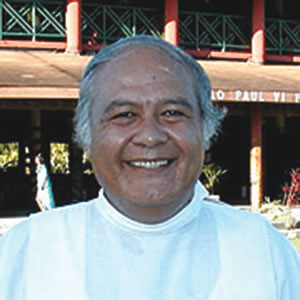Archbishop Alapati Lui Mataeliga
Born 4 January 1953,
Sataua, Savai’i,
Western Samoa
Ordained priest5 July 1977
Ordained Archbishop of Samoa-Apia 3 January, 2002
MM: What are your memories of being a student at Chanel College?
ABP: Oh, great memories of the early days. Quite daunting for a small boy from Savaii who knew hardly any English. It was a hard life but deeply formative, living in community with a group of Marist priests. We had Mass every morning, and lived as a family. I spent a lot of time in the library, and got on top of English which was necessary. Fr Doherty was a great teacher, not only in the classroom, but in life. We learned table manners and all kinds of skills for life.
MM: And you went on to further studies?
ABP: I felt called to priesthood and went to PRS in Suva, and later on to Rome where I studied Scripture. I was then asked to teach at the Seminary for some years. Then I was appointed to parish work in Samoa
MM: Your plans for the Archdiocese are already showing. Are you happy with the progress of the new Cathedral?
ABP: Yes, the community at Mulivai are really in behind the work. We have a talented priest guiding the project Fr Ricky Bernard, and the building is shaping up well. Money is tight but we are getting there.
MM: The country is celebrating 50 years of Independence “founded on God”. What do you consider the special gift of the Catholic Community in Samoa?
ABP: Well, it is quite obvious that the Catholic Church has done a lot in the area of education: fathers, mothers, Brothers and Sisters, for many years it has trained many of our leaders, matais, religious leaders – not just the Catholics, but also the non-Catholics - and the leaders in government, quite a few non-Catholic ministers and pastors who are doing doing well in their own churches. We have a contribution to make to the spiritual and moral wellbeing of Samoa; the Catholic Church having, for example, its social teaching. I think we have a lot to give and we can make an impact on the life of Samoa as being one of the mainline churches. To me, it’s a responsibility we have for Samoa. We don’t want to dominate but if we can, we make a very important contribution to that.
MM What are your hopes for the future of the country as a nation?
ABP As a spiritual leader, naturally you would hope that your country would remain faithful to God and keep the faith. I think that is the area where the Catholic Church can make a contribution. That is really my prayer and my hope: that we will remain a faithful and God-loving country. Also, it’s like a public statement for other small countries that with God it can be done. We try to live in the modern world which is not easy but it can be done when we place our trust and faith in God. It is all by grace.
MM What was the highlight for you during the Jubilee celebrations?
ABP Everything was important. I guess I should say one of the first things was it was really a joy to have you, some of the Marists, coming back. You brought back very many good memories of our time at Chanel. And the second was the fact that the old boys, those who started, the pioneers, so to speak, and the generations came out and shared their experiences. I think the students benefited from this, as you know. I think that was one of the most important moments of the jubilee, that time when the old students shared their experiences and stories. It was amazing.
MM Are you happy with the number of vocations?
ABP As a bishop and as a priest, I would hope to get more vocations and I think it is a challenge for us to pray for more vocations but still we have to count our blessings. We have to be grateful for what God is doing, I think, when we do get more vocations.
MM Tell me about the married deacons.
ABP Well, it was there in the early church, of course. It was very difficult to have the married deacons with the catechists. It took a while because there was no identity of the deacon but I think when we tried – at one stage we tried to put them together and that was not good, they are separate. We tried to develop the identity of the deacon; the catechists already had one. What I have discovered is that really the catechist is the deacon, in terms of formation, in terms of pastoral experience and so forth. That’s why when Cardinal Pio started the married deacons, he ordained some of the catechists. I thought that was a very good preparation for the married deacons, because what the catechists used to do is all over Samoa to be a help for the priests. What the catechists used to do, the deacon can do and more. So I think that now there is really no conflict between the two ministries. They complement each other. But it took a while to give the married deacons a chance to tell us who they are.

 Entries(RSS)
Entries(RSS)